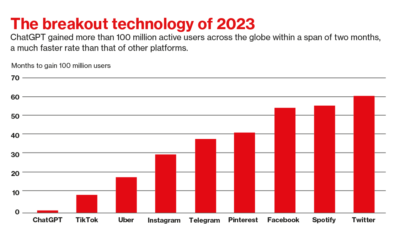Politics
Hybrid Workforce: Finding Balance Between Office and Remote Productivity
Published
1 year agoon
By
Drew Simpson
As the tides of change continue to shape the modern work landscape, the hybrid workforce model has emerged as an increasingly popular and compelling option for companies worldwide. By offering unparalleled flexibility and cost savings, it’s no wonder that more and more organizations are taking the plunge into this exciting new way of work.
According to a recent survey, a staggering 56% of hiring managers anticipate that hybrid work arrangements will soon become the standard work mode in the foreseeable future. However, with great innovation comes great challenges. For companies transitioning to a hybrid workforce, striking the right balance between remote and in-office work can be one of the most significant obstacles to overcome.
The question arises: how do companies divide their employees’ time most effectively between remote work and office work? In this article, we will dive deep into the myriad of challenges that come with achieving the perfect equilibrium of office and remote productivity, offering insights and strategies to help companies achieve a successful hybrid workforce.
Tips to Achieve Optimal Hybrid Workforce Productivity
Hybrid work is becoming the new norm, and with it comes the challenge of maintaining optimal productivity. Here are some tips to help you achieve just that:
- Set clear communication expectations: Foster a work environment that prioritizes consistent communication and leverages state-of-the-art technology to facilitate seamless collaboration while ensuring each team member has a clear delineation of their duties and obligations.
- Prioritize work-life balance: Empower your workforce to prioritize self-care and maintain a harmonious work-life equilibrium, fortifying against burnout and ensuring sustained productivity.
- Invest in the right technology: Leverage advanced technological tools, including video conferencing, team messaging applications, and project management software, to facilitate seamless connectivity between employees working remotely and those stationed in-office.
- Foster team building and camaraderie: Plan team building activities, encourage virtual coffee breaks, and provide opportunities for in-person gatherings to help foster a sense of community.
- Provide necessary resources and support: Ensure employees have access to the necessary resources, such as ergonomic office equipment, and provide the necessary support to ensure they can work effectively and efficiently.
By following these tips, you can achieve optimal hybrid workforce productivity and reap the benefits of a successful and sustainable work model.
The Benefits of a Hybrid Workforce
A harmonious interweaving of both physical and virtual workspaces, the hybrid workforce empowers employees with the freedom to work from any locale, providing them with unrivaled flexibility, while granting employers an avenue to curb operational costs. The potential advantages of this pioneering model are infinite. It bridges the great divide between office vs. remote, fostering a new paradigm of work that augments collaboration, promotes productivity, and fuels innovation.
During the time frame of January 25th to February 5th, 2023, an estimated 40% of gainfully employed individuals in Great Britain reported having conducted their work duties remotely at some point over the course of the previous seven days.
To begin with, hybrid work ushers in a new era of work-life balance, granting employees a higher degree of autonomy and agency in managing their personal responsibilities. This newfound control empowers workers to operate more efficiently, increasing productivity and overall job satisfaction.
Hybrid work models not only bring great benefits to organizations but also help the environment by diminishing traffic congestion, air pollution, and greenhouse gas emissions. On the other hand, employers can revel in the advantage of significantly lower overhead costs, including rent, utilities, and office supplies.
Moreover, hybrid workforce models enable organizations to tap into the vast global talent pool, allowing employers to access the most excellent talents worldwide. At the same time, employees can expand their career horizons beyond their geographical boundaries. As a result, hybrid work models are not just a trend but an intelligent solution that supports businesses, the environment, and talented individuals alike.
Challenges of a Hybrid Workforce
In the wake of the COVID-19 pandemic, a seismic shift has occurred in the way we work, and many companies have embraced the hybrid workforce model as a means of adapting to this new reality. While the advantages of this approach are manifold, it is not without its significant hurdles that must be surmounted. Below are outlined some of the most prevalent obstacles faced in implementing this new paradigm and the strategies that can be utilized to overcome them.
- Difficulty in communication and collaboration: Maintaining effective communication and collaboration in a hybrid workforce can be challenging due to the heterogeneity of employees working in the office and remotely. This can lead to misunderstandings, delays, and disharmony among team members, risking sub-optimal outcomes if not addressed.
- Inadequate work-life balance: The convenience of working from home may cause employees to struggle with separating their work and personal lives, leading to an erosion of healthy boundaries that exacerbates stress, exhaustion, and ultimately diminished output.
- Technological issues: To optimize the productivity of a hybrid workforce, a sturdy and dependable technological infrastructure is imperative, guaranteeing seamless communication, collaboration, and unfettered access to vital resources regardless of location. However, sluggish internet speeds, antiquated software, and inadequate hardware are some of the technological challenges that could potentially impede the performance of a hybrid workforce.
- Challenges in team building and morale: Remote work may bring about a sense of seclusion and detachment from the team, causing a detrimental impact on both morale and team-building initiatives. This is particularly arduous for fresh hires who strive to forge camaraderie with their peers. It can be the difference between a smooth transition into the workforce and a lackluster start to their career journey.
Final Thoughts
The rise of the hybrid workforce ushers in a new era of both challenge and opportunity for organizations seeking to thrive. Achieving the optimal balance between office and remote productivity is paramount to success. This can be accomplished through the implementation of clear communication channels, the strategic use of cutting-edge technology, and the cultivation of a culture of work-life balance and team building.
It is the organizations that can recognize the unique advantages of a hybrid workforce and adopt a mindset of adaptability, trust, collaboration, and innovation that will truly excel in this new digital age. By embracing the full potential of the hybrid workforce, these organizations can lay the foundation for growth and success, making them well-positioned for long-term achievement and prosperity.
Featured Image Credit: Photo by Rebrand Cities; Pexels; Thank you!
Micheal Chukwube
Experienced PR Strategist, Content Writer, and Tech Enthusiast. Published in Techopedia, Infosecurity magazine, HackerNoon, Dzone and more.
Ready to work with me to grow your brand’s online visibility? Get in touch via: Chukwubemicheal@gmail.com
You may like
-


Finding value in generative AI for financial services
-


Return to the Office: Trends and Tips to Make You a Success
-


FlexiSpot Ergonomic Office C7 | Full Review
-


Can Hybrid Intelligence Opens Up New Opportunities In Healthcare
-


Generative AI is empowering the digital workforce
-


Turbo-charging productivity in Asia: the economic benefits of generative AI
Politics
Fintech Kennek raises $12.5M seed round to digitize lending
Published
7 months agoon
10/11/2023By
Drew Simpson
London-based fintech startup Kennek has raised $12.5 million in seed funding to expand its lending operating system.
According to an Oct. 10 tech.eu report, the round was led by HV Capital and included participation from Dutch Founders Fund, AlbionVC, FFVC, Plug & Play Ventures, and Syndicate One. Kennek offers software-as-a-service tools to help non-bank lenders streamline their operations using open banking, open finance, and payments.
The platform aims to automate time-consuming manual tasks and consolidate fragmented data to simplify lending. Xavier De Pauw, founder of Kennek said:
“Until kennek, lenders had to devote countless hours to menial operational tasks and deal with jumbled and hard-coded data – which makes every other part of lending a headache. As former lenders ourselves, we lived and breathed these frustrations, and built kennek to make them a thing of the past.”
The company said the latest funding round was oversubscribed and closed quickly despite the challenging fundraising environment. The new capital will be used to expand Kennek’s engineering team and strengthen its market position in the UK while exploring expansion into other European markets. Barbod Namini, Partner at lead investor HV Capital, commented on the investment:
“Kennek has developed an ambitious and genuinely unique proposition which we think can be the foundation of the entire alternative lending space. […] It is a complicated market and a solution that brings together all information and stakeholders onto a single platform is highly compelling for both lenders & the ecosystem as a whole.”
The fintech lending space has grown rapidly in recent years, but many lenders still rely on legacy systems and manual processes that limit efficiency and scalability. Kennek aims to leverage open banking and data integration to provide lenders with a more streamlined, automated lending experience.
The seed funding will allow the London-based startup to continue developing its platform and expanding its team to meet demand from non-bank lenders looking to digitize operations. Kennek’s focus on the UK and Europe also comes amid rising adoption of open banking and open finance in the regions.
Featured Image Credit: Photo from Kennek.io; Thank you!
Radek Zielinski
Radek Zielinski is an experienced technology and financial journalist with a passion for cybersecurity and futurology.
Politics
Fortune 500’s race for generative AI breakthroughs
Published
7 months agoon
10/11/2023By
Drew Simpson
As excitement around generative AI grows, Fortune 500 companies, including Goldman Sachs, are carefully examining the possible applications of this technology. A recent survey of U.S. executives indicated that 60% believe generative AI will substantially impact their businesses in the long term. However, they anticipate a one to two-year timeframe before implementing their initial solutions. This optimism stems from the potential of generative AI to revolutionize various aspects of businesses, from enhancing customer experiences to optimizing internal processes. In the short term, companies will likely focus on pilot projects and experimentation, gradually integrating generative AI into their operations as they witness its positive influence on efficiency and profitability.
Goldman Sachs’ Cautious Approach to Implementing Generative AI
In a recent interview, Goldman Sachs CIO Marco Argenti revealed that the firm has not yet implemented any generative AI use cases. Instead, the company focuses on experimentation and setting high standards before adopting the technology. Argenti recognized the desire for outcomes in areas like developer and operational efficiency but emphasized ensuring precision before putting experimental AI use cases into production.
According to Argenti, striking the right balance between driving innovation and maintaining accuracy is crucial for successfully integrating generative AI within the firm. Goldman Sachs intends to continue exploring this emerging technology’s potential benefits and applications while diligently assessing risks to ensure it meets the company’s stringent quality standards.
One possible application for Goldman Sachs is in software development, where the company has observed a 20-40% productivity increase during its trials. The goal is for 1,000 developers to utilize generative AI tools by year’s end. However, Argenti emphasized that a well-defined expectation of return on investment is necessary before fully integrating generative AI into production.
To achieve this, the company plans to implement a systematic and strategic approach to adopting generative AI, ensuring that it complements and enhances the skills of its developers. Additionally, Goldman Sachs intends to evaluate the long-term impact of generative AI on their software development processes and the overall quality of the applications being developed.
Goldman Sachs’ approach to AI implementation goes beyond merely executing models. The firm has created a platform encompassing technical, legal, and compliance assessments to filter out improper content and keep track of all interactions. This comprehensive system ensures seamless integration of artificial intelligence in operations while adhering to regulatory standards and maintaining client confidentiality. Moreover, the platform continuously improves and adapts its algorithms, allowing Goldman Sachs to stay at the forefront of technology and offer its clients the most efficient and secure services.
Featured Image Credit: Photo by Google DeepMind; Pexels; Thank you!
Deanna Ritchie
Managing Editor at ReadWrite
Deanna is the Managing Editor at ReadWrite. Previously she worked as the Editor in Chief for Startup Grind and has over 20+ years of experience in content management and content development.
Politics
UK seizes web3 opportunity simplifying crypto regulations
Published
7 months agoon
10/10/2023By
Drew Simpson
As Web3 companies increasingly consider leaving the United States due to regulatory ambiguity, the United Kingdom must simplify its cryptocurrency regulations to attract these businesses. The conservative think tank Policy Exchange recently released a report detailing ten suggestions for improving Web3 regulation in the country. Among the recommendations are reducing liability for token holders in decentralized autonomous organizations (DAOs) and encouraging the Financial Conduct Authority (FCA) to adopt alternative Know Your Customer (KYC) methodologies, such as digital identities and blockchain analytics tools. These suggestions aim to position the UK as a hub for Web3 innovation and attract blockchain-based businesses looking for a more conducive regulatory environment.
Streamlining Cryptocurrency Regulations for Innovation
To make it easier for emerging Web3 companies to navigate existing legal frameworks and contribute to the UK’s digital economy growth, the government must streamline cryptocurrency regulations and adopt forward-looking approaches. By making the regulatory landscape clear and straightforward, the UK can create an environment that fosters innovation, growth, and competitiveness in the global fintech industry.
The Policy Exchange report also recommends not weakening self-hosted wallets or treating proof-of-stake (PoS) services as financial services. This approach aims to protect the fundamental principles of decentralization and user autonomy while strongly emphasizing security and regulatory compliance. By doing so, the UK can nurture an environment that encourages innovation and the continued growth of blockchain technology.
Despite recent strict measures by UK authorities, such as His Majesty’s Treasury and the FCA, toward the digital assets sector, the proposed changes in the Policy Exchange report strive to make the UK a more attractive location for Web3 enterprises. By adopting these suggestions, the UK can demonstrate its commitment to fostering innovation in the rapidly evolving blockchain and cryptocurrency industries while ensuring a robust and transparent regulatory environment.
The ongoing uncertainty surrounding cryptocurrency regulations in various countries has prompted Web3 companies to explore alternative jurisdictions with more precise legal frameworks. As the United States grapples with regulatory ambiguity, the United Kingdom can position itself as a hub for Web3 innovation by simplifying and streamlining its cryptocurrency regulations.
Featured Image Credit: Photo by Jonathan Borba; Pexels; Thank you!
Deanna Ritchie
Managing Editor at ReadWrite
Deanna is the Managing Editor at ReadWrite. Previously she worked as the Editor in Chief for Startup Grind and has over 20+ years of experience in content management and content development.
